How to Prevent or Stop DDoS Attacks on WordPress Website?
Bulletproof Backups for Your WordPress Website
Fortify your business continuity with foolproof WordPress backups. No data loss, no downtime — just secure, seamless operation.
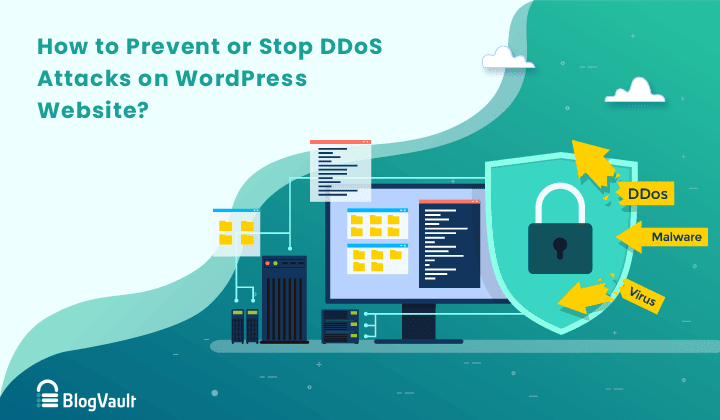
Worried that your website will be a target for DDoS attacks? We wish we could tell you not to worry but the truth is, DDoS attacks are one of the most common types of attacks made on your WordPress website.
DDoS attackers flood your server and make your site unresponsive and inaccessible. Your website and your business can come to a grinding halt.
In addition, DDoS attacks sometimes go undetected for long periods of time as site owners explore different possible causes of the problem. In the time taken to figure out that it’s a DDoS attack, the damage becomes more severe.
As a result, you start to lose visitors and your SEO rankings plummet. The financial implications on account of lost revenue and recovery costs can skyrocket.
Taking measures to stop and prevent DDoS and being prepared in the event of an attack is essential to your website and your business.
In this article, we’ll show you how to prevent DDoS attacks on your website. We’ll also guide you through the exact steps that you can take when your website is under a DDoS attack.
TL;DR
To prevent DDoS attacks, you need a firewall to block fake and malicious traffic requests from accessing your site. Use our MalCare Security Plugin and it will automatically set up a firewall on your site. The firewall will detect unwanted traffic and block it before it can access your site.
[lwptoc skipHeadingLevel=”h1,h3,h4,h5,h6″ skipHeadingText=”Final Thoughts”]
What is a DDoS Attack?
Generally, hackers look for a vulnerability on your WordPress website that they can exploit to break into the website. Once they have access to your website, they can cause all sorts of damage to your site.
But DDoS (Distributed Denial of Service) are non-intrusive attacks. This means the hacker does not need to access your site to cause damage to the site.
How does a hacker attack my site without breaking in?
DDoS attacks are a bit technical in nature but we’ll simplify it as much as possible.
1. Your website runs on a web server. Every time a visitor types in your website’s URL in their browser (such as Google Chrome or Mozilla Firefox), the browser sends a request to this server. The server fetches the data of your site and sends it back to the web browser. Next, the data is used by the web browser to display your website and its content to the visitor.
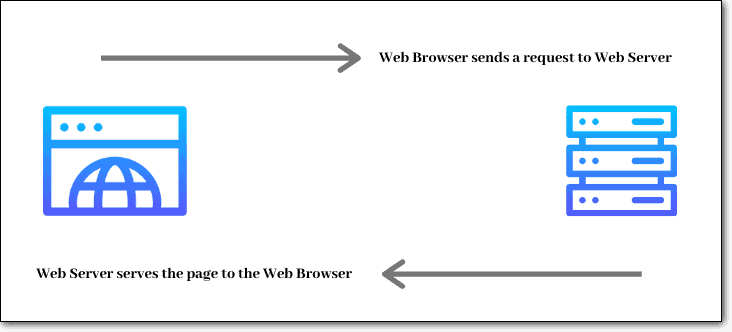
What is important to know here is that every request that a visitor makes on your site uses up some amount of your server’s resources. And your server has limited resources available.
2. In a DDoS attack, hackers program hundred of thousands of malicious bots and devices to send requests to your website. Each request will consume server resources till your server is exhausted. This flooding attack will make your WordPress site slow and unresponsive. In some cases, a sudden spike in traffic like this can cause your server to crash and your site goes offline.
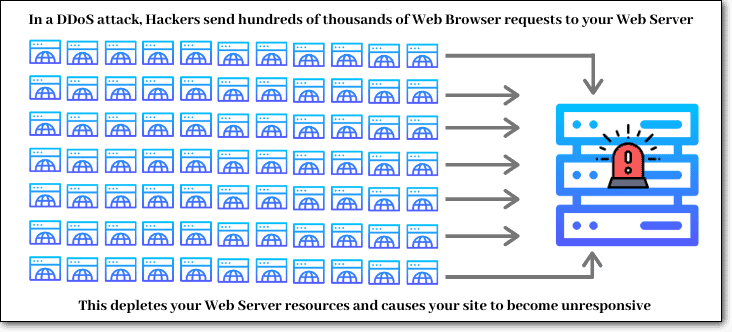
Once you have a fair understanding of DDoS attacks, we can proceed to take steps to prevent such an attack on your WordPress site.
How to Prevent a DDoS Attack on Your WordPress Website?
Since a DDoS volumetric attack is an external attack, regular security measures will not work. Usually, we would advise you to install a security scanner and implement WordPress hardening measures to protect your website from hackers. While you should still have those measures in place, when it comes to DDoS, you need to approach this very differently. We will discuss four measures you need to take to prevent DDoS attacks:
- Install A Firewall
- Monitor Your Site’s Traffic
- Monitor Your Site’s Data Usage
- Implement Geoblocking
You can use these measures to prevent DDoS as well as recognize attacks early on. By detecting a DDoS attack early on, you can take measures to mitigate the attack and prevent your website from crashing.
1. Install A Firewall
A web application firewall plugin will analyze requests that come to your WordPress site. It will detect malicious traffic requests and block them from accessing your site, therefore, blocking any hack attempts
Installing a firewall on your WordPress site is easy. There are plenty of WordPress firewall plugins that enable you to set up a firewall on your site in just a few minutes. But as we mentioned, DDoS attacks are very different and not all WordPress firewalls will work. You need a firewall that protects against DDoS attacks. Such firewalls are specifically designed to identify a DDoS attack and block those traffic requests.
Let’s explain this further so that you get a better understanding. But to keep things simple, we won’t delve deep into the technical aspects.
There are two kinds of traffic requests we need to address here:
- The first kind of request uses your WordPress installation. For example, when you visit yourdomain.com/about-us, this kind of request loads your WordPress installation. Your WordPress site will load and the About Us page of your WordPress site will be displayed on your web browser. All WordPress application firewalls are designed to capture these traffic requests.
- The second kind of request uses your server. It doesn’t require your WordPress site to load. For example, yourdomain.com/wp-content/uploads/2011/08/image1.png requests for one of your image files from your WordPress directory. Many WordPress firewalls will not be able to capture this request as the firewall is installed on your WordPress site and not on a server level.
To prevent DDoS attacks, you need a firewall that is designed to capture both kinds of requests. Our MalCare WordPress security plugin has an in-built robust firewall. MalCare is soon releasing a new and improved WordPress firewall that will be able to capture both kinds of requests and reduce the risk of DDoS attacks on your WordPress website.
When you install MalCare on your WordPress site, the firewall is automatically installed. You can access the firewall from the MalCare dashboard. Select your site and go to Security.

Here, you can view the details of the firewall’s activity. You can see if hackers are making login attempts on your site. You can also check which IP addresses the firewall is blocking.
This will help you understand if the DDoS attack is also a brute force attack.
2. Monitor Your Site’s Traffic
There are no warning signs of a DDoS attack. It can happen fast and all of a sudden. Many website owners first mistake a DDoS attack to be a problem with the site such as an incompatibility issue or a fault plugin. They may also think the WordPress host is experiencing trouble with their server. It could take hours or days before the site owner realizes they are under attack.
One of the best ways to prevent a DDoS attack is to spot it early on and stop it in its tracks before it causes serious damage. To do this, you need a real-time traffic log.
A traffic log will monitor the incoming traffic to your WordPress site. Here too, you need a traffic log that will capture both kinds of requests we discussed under Firewalls.
If you’ve installed MalCare, you will automatically have access to a traffic log. To access this log, go to the MalCare dashboard, under Firewall, you will see an option ‘Traffic Logs’.
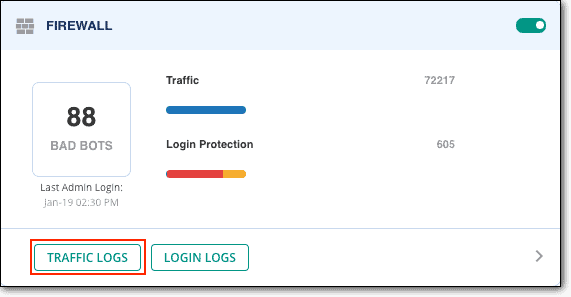
Inside, you will see a list of IP addresses that have made a request to visit your site. You can view all the details such as what time the requests were made, which page or file was requested, and even which country the request originates from.

When you notice your site’s speed has slowed down or your site is down, you can immediately access this log and check if you are receiving unusually high traffic. If you witness a sudden spike in traffic requests, you can be sure it’s a DDoS attack.
Catching the attack early can help you take measures to stop it fast. In case your website is under attack, we have discussed how to stop a DDoS attack in the next section.
3. Monitor your website’s data usage
In a DDoS attack, hackers overload your server and exhaust its resources. You can check your website’s statistics and usage of resources in your web hosting account. If you notice that your site is not responding, you should immediately check how much of your website’s resources are being used.
Visit your web hosting account and access your dashboard. Go to ‘Manage hosting’. This is where most web hosts display the usage statistics of your WordPress site.

Usually, your website takes a long time to reach its limit. Unless you’re running a large website on a low-end hosting plan, these stats should be within mid-range limits.
We recommend you monitor your usage statistics once a month. If you notice your website is suddenly unresponsive, you can check to see if there’s a spike in your usage statistics. This will indicate a DDoS attack.
Knowing where to check these statistics will help you understand what’s happening to your site. You can catch an incoming DDoS attack early on and prevent it from taking your site down.
4. Implementing Geoblocking
In many cases, the majority of the DDoS requests being sent to your site originates in one or two particular countries. By checking the traffic log we mentioned above, if you see a concentration of requests in a particular country, you can block all IP addresses that originate from that country.
This will greatly help in preventing the attack from being successful by reducing its intensity. You must bear in mind that blocking an entire country can be used as a temporary solution to mitigate a DDoS attack and works well if used in tandem with the measures mentioned above.
However, we do not recommend blocking an entire country as a stand-alone measure of WordPress DDoS protection. Hackers can use proxy servers to bounce their request off different servers to make it look like that hack originates elsewhere.
To block a country from accessing your website, there are a few plugins you can use. If you’ve installed MalCare, you can access the dashboard and select your site.
Next, select Manage and Geoblocking.
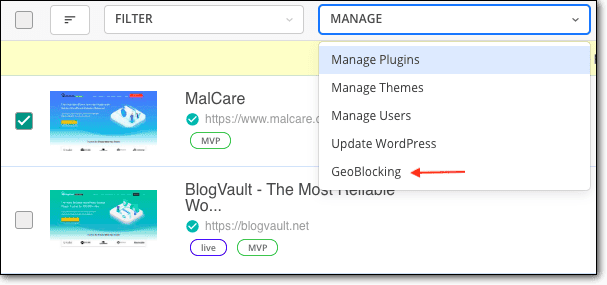
Here, you can select the countries you want to block, and save your changes. You can use the same method to unblock countries as well.
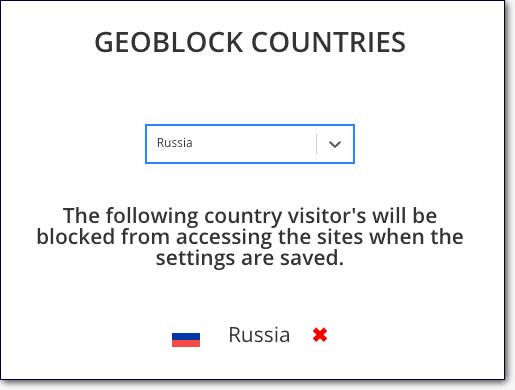
These three measures will greatly help in preventing and mitigating DDoS attacks on your site. In case your website is already under attack, we’ve detailed the steps you need to take in the next section.
How to Stop a DDoS Attack on Your WordPress Site?
We know that a DDoS attack is different as it’s targeted at your server. So implementing regular WordPress site security measures will not suffice. Here are a few measures you need to take immediately if you think that your site is under attack:
1. Contact your web host
If you’re facing a DDoS attack, you should get in touch with your web host immediately. Inform them of the attack and ask them what measures they can take. They might suggest pulling your site offline temporarily to secure your web server. This will stall the attack and you can implement protective measures like installing a firewall.
2. Hire professionals
A DDoS attack is not like a regular attack and thus, regular security measures aren’t sufficient. It might be in your best interest to hire professional security services. They will take measures to help you stop the attack. They will also install anti-DDoS protection on your site to prevent future attacks.
3. Install a security plugin
In many cases, DDoS attacks are used in tandem with other hacks such as brute force attacks or data theft. While you are busy fixing the DDoS attack, they hack into your site to steal confidential data or deface your site. We recommend that you install a security plugin immediately on your WordPress site. Such plugins will help secure your WordPress website from common hack attempts like brute force attacks, spam links, and SQL injections. If your site is infected, the plugin will alert you of the infected files and you can promptly clean up the hack.
In the unlikely event that you are unable to stop the attack, as a last resort, you could just wait it out. DDoS attacks will eventually stop. This is definitely not a viable option for eCommerce sites and large businesses as the costs of recovery and financial losses will be exorbitant. It could also spell disaster for small sites such as bloggers whose livelihood depends on ad revenue.
With that, we conclude our guide on securing your website against WordPress DDoS attacks. If you implement these preventive measures, your website will be better protected from DDoS attacks.
Final Thoughts
DDoS targeting attacks are a serious cyber threat that can cause severe damage to your WordPress site and your business. Recovering from these attacks is tedious and expensive.
It’s best to take preventive measures against DDoS attacks. We strongly recommend using our new MalCare firewall that can detect and mitigate DDoS attacks. In addition, it will protect you from other kinds of hack attacks! You can monitor your site’s security and performance.
Protect Your Site Against DDoS Attacks With MalCare’s Firewall!
Tags:
Share it:
You may also like

How to Limit Form Submissions with Droip in WordPress
Forms are an indispensable part of any website because of their versatility, letting you collect information for various purposes! However, people with ill intentions often attempt to exploit these forms…

How To Manage Multiple WordPress sites
Management tools help agencies become well-oiled machines. Each task is completed with the least amount of effort and highest rate of accuracy. For people managing multiple WordPress sites, the daily…

PHP 8.3 Support Added to Staging Feature
We’ve introduced PHP version 8.3 to our staging sites. Test out new features, code changes, and updates on the latest PHP version without affecting your live website. Update PHP confidently…
How do you update and backup your website?
Creating Backup and Updating website can be time consuming and error-prone. BlogVault will save you hours everyday while providing you complete peace of mind.

Updating Everything Manually?
But it’s too time consuming, complicated and stops you from achieving your full potential. You don’t want to put your business at risk with inefficient management.

Backup Your WordPress Site
Install the plugin on your website, let it sync and you’re done. Get automated, scheduled backups for your critical site data, and make sure your website never experiences downtime again.




